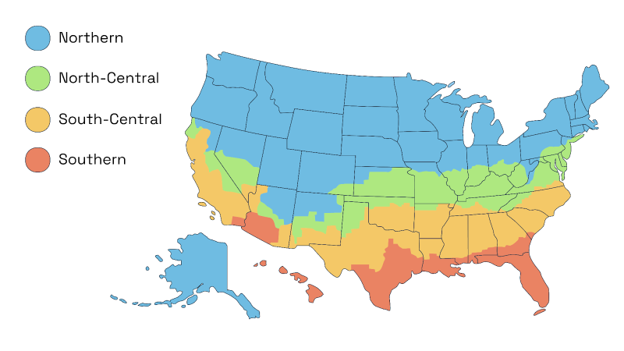Any window worth their salt would be certified by ENERGY STAR.
ENERGY STAR is a voluntary energy efficiency program established by the U.S. that promotes energy-efficient products and practices by certifying products that meet strict energy efficiency guidelines. Here’s an example of an ENERGY STAR label:

The ENERGY STAR label, that can be found on windows from an ENERGY STAR partner signifies their energy efficiency.
The Anatomy of an ENERGY STAR Label
In order for a window to be ENERGY CERTIFIED, a list of requirements must be achieved within acceptable energy performance ratings. Here are the performance ratings that needs to be achieved (they will also be listed on the label itself):
U-factor
This measures how well the window insulates. A lower U-factor indicates better insulation, meaning less heat transfer between the interior and exterior of the building.
Solar Heat Gain Coefficient (SHGC)
This measures how much solar heat is transmitted through the window.

A lower SHGC indicates that the window blocks more solar heat, which can help reduce cooling costs in warm climates.
Visible Transmittance (VT)
This measures how much visible light passes through the window. A higher VT means more natural light enters the building, reducing the need for artificial lighting during the day.
Air Leakage (AL)
This measures how much air passes through the window assembly. ENERGY STAR-certified windows typically have lower air leakage rates, which helps improve energy efficiency by reducing drafts.
Condensation Resistance
This measures how well the window resists condensation forming on its surface. Higher condensation resistance ratings indicate that the window is less likely to experience condensation, which can help prevent moisture-related issues like mold and mildew.
Now that we’ve familiarized ourselves with the ENERGY STAR label, it is important to note that there isn’t a perfect rating per se.
Different windows can be ENERGY STAR certified and yet have massively different figures in their performance rating. This is because climate plays a huge role in determining the performance rating in a window.
The Ideal Climate-Based Performance Rating
The US has a wide range of climates, and any performance rating will have to take that into consideration.
Warmer climates will require a different approach than those of colder climates, and the two ratings that will have a huge change are the solar heat gain coefficient and U-factor ratings. Each region has its own U-factor and SHGC requirements to meet before being ENERGY STAR certified, and here are the figures:

As previously mentioned, solar heat gain coefficient determines the amount of solar heat to pass through the window. Warmer climates would prefer this to be lower to keep living spaces cool. On the other hand, living spaces in colder climates would want the opposite effect, letting in more solar heat as a natural method of warming up the interior.
This also applies to the U-factor. Since lower U-factor means better heat insulation, it works better for colder climates, while hotter climates would prefer a higher U-factor, allowing heat to escape and keeping the space cool.
The certification criteria are based on four different climate zones: Northern, North-Central, South-Central, and Southern (we will explore the regions in greater detail further down).
The Four ENERGY STAR Climate Zones
The four climate zones are roughly based on this map.

Northern Climates
Generally defined as areas where there are cold winters, but with summers that are relatively mild. Heat retention in living spaces takes priority.

States that generally fall under this category are Alaska, Maine, New Hampshire, Vermont, Massachusetts, Rhode Island, Connecticut, New York, Michigan, Wisconsin, Minnesota, North Dakota, South Dakota, Montana, Wyoming, Idaho, Washington, Oregon, and northern parts of other states such as Illinois, Iowa, Nebraska, and Nevada.
North-Central Climates
Areas with this climate have both hot summers and cold winters. Windows certified for these areas must have a balanced rating to ensure that the living space is energy efficient in both types of weather.
States with North-Central climates are Ohio, Pennsylvania, West Virginia, Indiana, Kentucky, Virginia, Maryland, Delaware, New Jersey, Illinois, Missouri, Iowa, Kansas, Nebraska, Colorado, Utah, Nevada, and parts of Michigan, Wisconsin, Minnesota, and Wyoming.
South-Central Climates
Areas where their summers are hot, but their winters are mild. Windows here focus more on reducing heat within the living spaces.
States with South-Central climates are Texas, Oklahoma, Arkansas, Louisiana, Mississippi, Alabama, Tennessee, Georgia, Florida, South Carolina, North Carolina, and parts of Virginia, Kentucky, Missouri, Kansas, and New Mexico
Southern Climates
They feature hot and humid summers, with even milder winters. The priority of windows in this area is to let heat out of the living space.

States with Southern climates are Arizona, New Mexico, California, Hawaii, and southern parts of Texas, Nevada, Louisiana, Mississippi, Alabama, Georgia, South Carolina, North Carolina, Virginia, Maryland, Delaware, and Florida.
Shifting Climates and Accuracy
It is important to note that climates are not consistent and can change from year to year. Shifting weather patterns also mean that the efficiency of a window might vary as well. Furthermore, some states such as California or Texas have multiple climate zones, and depending on how far north or south, will require a type of window.
If you are unsure about the climate and ENERGY STAR requirements of a state, ENERGY STAR provides a website for reference not just for the state, but down to the specific county, which you can check here. Regular updates on states and counties are also listed in a spreadsheet that can be found here.
How Vistaza Can Help
If you were looking at the ENERGY STAR label above, you might’ve noticed that the label is for Vistaza products. Well, that’s because Vistaza is an ENERGY STAR partner, and carries ENERGY STAR certified windows.
We can assist developers outfit buildings with windows that are best suited for the specific climate zones, allowing for energy efficient windows that provide large cost-savings benefits in the future.




